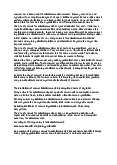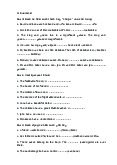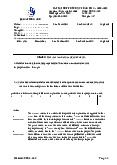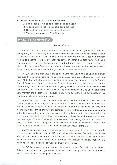


Preview text:
HOMEWORK WEEK 2
1/ What is the view of Alan Duff (1989) about needs and benefits of translation?
1. Influence of the mother tongue
We all have a mother tongue, or first language. This shapes our way
of thinking, and to some extent our use of the foreign language
(pronunciation, choice of words, tone, word order, etc.,)
Translation helps us to understand better the influence of the one
language on the other, and to correct errors of habit that creep in
unnoticed (such as the misuse of particular words or structures).
And, because translation involves contrast, it enables us to explore
the potential of both languages – their strengths and weaknesses
2. Naturalness of the activity
Translation is a natural and necessary activity. More so, indeed, than
many of the fashionable activities invented for language learners.
Outside the classroom – in offices, banks, factories, shops, and
airports – translation is going on all the time. Why not inside the classroom? 3. The skills aspect
Language competence is a two-way, not a one-way system. We
need to be able to communicate both ways: into and from the
foreign language. Textbooks, understandably, place great emphasis
on competence in the foreign language. Yet little guidance is given
on how to communicate back into the mother tongue, as many
professionals need to do in their daily work. Translation is ideally
suited for practising this vital skill.
4. The reality of language
The proper matercial of translation is authentic, not "made - up"
language. And all language is relevant to translation - all styles and
registers of both speech and writing. Translation need not be confined to literature!
Because the material is authentic and wide-ranging in scope, the
learner is being brought into touch with the whole language, and not
just those parts isolated by the textbook. This is an aim to be found
in almost all course descriptions: 'to increase the students' power
and range of expression. Translation will certainly do this. 5. Usefulness
As a language learning activity, translation has many merits. Chiel among these are:
a. It is an activity which, by its very nature, invites speculation
and discussion. In translation, there is rarely 'right' answer
(though there may be several wrong ones!). It is not necessary
for all the work in class to be done alone and in writing.
Students can work in groups for oral discussion. The texts,
which can be very short, serve as material both for reading and for discussion.
b. Translation develops these qualities essential to all language
learning: accuracy, clarity, and flexibility. It trains the learner to
search (flexibility) for the most appropriate words (accuracy) to
convey what is meant (clarity). This combination of freedom
and constraint allows the students to contribute their own
thoughts to a discussion which has a clear focus - the text.
c. Depending on the student's needs, and on the syllabus, the
teacher can select material to illustrate particular aspects of
language and structure with which the students have difficulty
in English (for in stance, prepositions, articles, if - clauses, the
passive ). By working through these difficulties in the mother
tongue, the students come to see the link between language (grammar) and usage.
An example of this is the use of the passive in signs and notices
(PARKING PROHIBITED, NO CREDIT ALLOWED) in English. In another
language these might be rendered differently (Do no Park Here, We Give No Credit)
d. Translation will always be needed. Without them, there would
be no summit talks, no glasnost or perestroika, no Cannes Film
Festival, no Nobel prizes, no advances in medicine, science, or
engineering, no international law, no Olympic Games, no Hamlet, no War and Peace...
And who is to do all this necessary work? Either the professionals
themselves, or the students of language. Only translation can give them the training they need.
2/ In chapter 1, a syntactic construction is mentioned in 4
types. What types are they?
Adverbial Clause, Participial Phrase, Prepositional Phrase and Relative Clause.
3/ What do we need to do when we meet an ambiguous translation text?
Translation ambiguity occurs when a word in one language can be
translated in more than one way into another language. This cross-
language phenomenon comes from several sources of within-
language ambiguity including lexical ambiguity, polysemy, and near-
synonymy. Remember, language ambiguity sometimes sounds
interesting; however, it could also lead to profound
misunderstanding. Just know when it is appropriate to use it, and
always let others read your piece in a case if you do not intend to
use it. Some linguistic contexts do not provide sufficient information
to disambiguate a used word. Lexical ambiguity can be addressed
by algorithmic methods that automatically associate the appropriate
meaning with a word in context, a task referred to as word-sense
disambiguation. So what we need to do are: o Use a Summarizing Word o
Use a Gerund (the ing form of the verb) o Use an Infinitive o Use a That Clause
4/ Let's figure out the ambiguity of 5 sentences on page 36.
1. Ngay lúc cơn giận dữ đang dâng trào thì không được phép đưa ra quyết định.
2. Theo Bộ Lao động Anh, Chính phủ Anh tác động đến Quỹ Thị
trường chung châu Âu để đào tạo nhân công nữ tránh khỏi bị phân biệt đối xử.
3. Đã 8 năm kể từ nỗi trăn trở của cô ấy, khi đó, điều thắc mắc ấy đã đi thẳng vào vấn đề.
4. Kinh tế thế giới đang dần được phục hồi.
5. Bạn có thể đi vòng quanh đường Mary mà không gặp phải hàng
rào kẽm gai hay các biển báo chỉ “tránh ra”.




